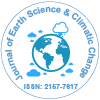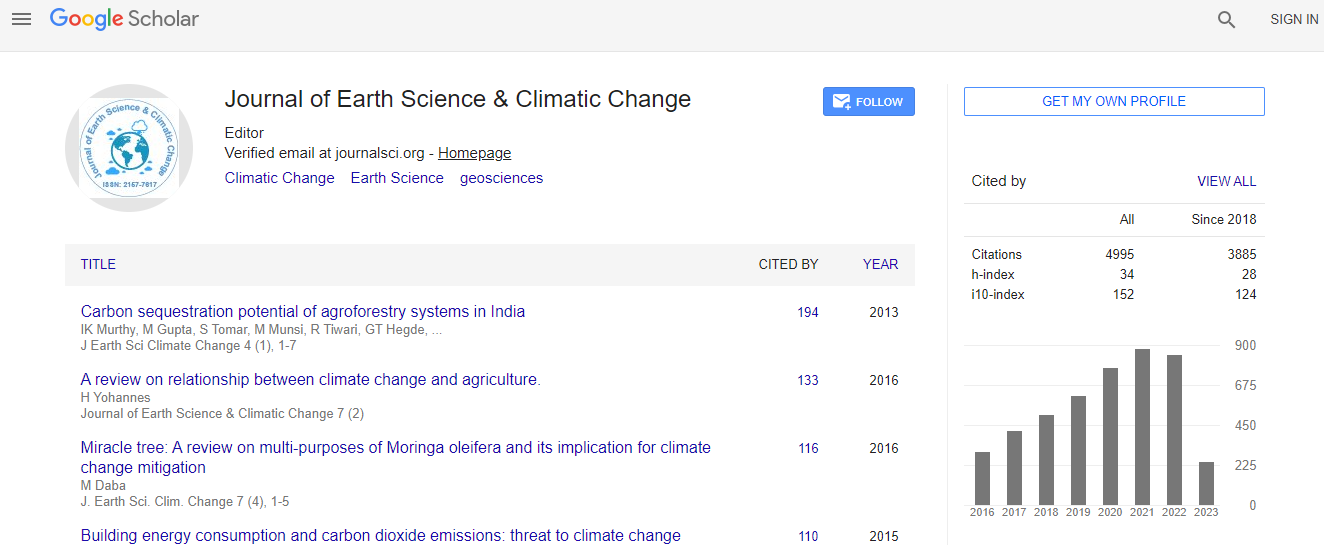Our Group organises 3000+ Global Conferenceseries Events every year across USA, Europe & Asia with support from 1000 more scientific Societies and Publishes 700+ Open Access Journals which contains over 50000 eminent personalities, reputed scientists as editorial board members.
Open Access Journals gaining more Readers and Citations
700 Journals and 15,000,000 Readers Each Journal is getting 25,000+ Readers
Google Scholar citation report
Citations : 5125
Journal of Earth Science & Climatic Change received 5125 citations as per Google Scholar report
Journal of Earth Science & Climatic Change peer review process verified at publons
Indexed In
- CAS Source Index (CASSI)
- Index Copernicus
- Google Scholar
- Sherpa Romeo
- Online Access to Research in the Environment (OARE)
- Open J Gate
- Genamics JournalSeek
- JournalTOCs
- Ulrich's Periodicals Directory
- Access to Global Online Research in Agriculture (AGORA)
- Centre for Agriculture and Biosciences International (CABI)
- RefSeek
- Hamdard University
- EBSCO A-Z
- OCLC- WorldCat
- Proquest Summons
- SWB online catalog
- Publons
- Euro Pub
- ICMJE
Useful Links
Recommended Journals
Related Subjects
Share This Page
In Association with

Monitoring and analysis of formaldehyde concentration over Rawalpindi-Islamabad Pakistan using MAX-DOAS and satellite observation
3rd World Congress on Climate Change and Global Warming
Waqas Ahmed Khan
The University of Lahore, Pakistan
ScientificTracks Abstracts: J Earth Sci Clim Change
Abstract
Formaldehyde (HCHO) is an intermediate product in the oxidation paths of non-methane hydrocarbons produced through biogenic activities and anthropogenic sources. Formaldehyde is a flammable, colorless, strong-smelling chemical that is use to produce numerous domestic products and medical preservatives. Formaldehyde is also present naturally in the environment and produced in lesser amounts by most organisms as part of normal metabolic processes. Pakistan lacks the monitoring facilities on a larger scale to measure the atmospheric gasses on regular basis. The study presents the result of atmospheric Formaldehyde vertical column densities (VCDs) obtained from ground-based and satellite observations over Pakistan during the time period of 2014-2015. In order to explore the spatial distribution of Formaldehyde, various field campaigns were conducted by using Car MAX-DOAS instrument in which international scientists were also involved. Level 2 data product of satellite; Ozone Monitoring Instrument (OMI) retrieved by differential optical absorption spectroscopy (DOAS) technique was also compared with ground-based observations. Spatio-temporal distribution of Formaldehyde (HCHO) column densities over main cities and region of Pakistan are discussed. The results show that high Formaldehyde (HCHO) column densities 108 ppm exceeding permissible limit of WHO 83 ppm, were found over twin cities Rawalpindi-Islamabad of Pakistan. The highest VCDs were around 1.0Ã?Â?1016 to 8.5 Ã?Â?1016 molecules/cm2 higher than WHO guide lines, while in Pir-Sohawa valley where there is less population and vehicular emission; HCHO VCDs were found within WHO permissible limits. Similarly, areas with major industrial activity and high population densities showed high amount of HCHO concentrations.Biography
Waqas Ahmed khan is serving as a lecturer in University of Lahore, Pakistan in the department of Environmental sciences.

 Spanish
Spanish  Chinese
Chinese  Russian
Russian  German
German  French
French  Japanese
Japanese  Portuguese
Portuguese  Hindi
Hindi 
